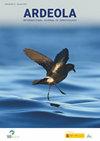Testing Detectability of Radio-Tracked Tawny Owls Using Playback Broadcast Surveys: Designing Evidence-Based Surveys
IF 1.4
4区 生物学
Q2 ORNITHOLOGY
引用次数: 6
Abstract
Summary. Owls, like other secretive species, are difficult to detect. During the last few decades, protocols used for surveying owls have revealed the best methods to acquire accurate data about their distribution and abundance. However, these protocols were established by testing the response of owls to playback of broadcast calls, using wild, unknown individuals that were only noticeable when vocalisations were given/detected. Therefore, there is no clear consensus on the best method to survey owls. We tested a protocol to survey Tawny Owls Strix aluco using 20 radio-tracked individuals in two study areas with contrasting owl density. We conducted 58 survey tests during winter 2014-2015. In the two study areas respectively, 61.3% and 70.4% of the target individuals responded, on average, within the first six minutes after the start of call playback. Naïve occupancy estimates were 67.7% and 85.2%, respectively, considering the combined responses of the target individual and its mate. We detected a movement of the target owls from their original position towards the playback source on 72.4% of the sampling occasions in both areas. Tawny Owls approached within 50m of the playback point on only 56.9% of occasions. Mates or neighbours responded to broadcast calls more often in the high-density area than in the low density one. The detection probability of target owls increased more than fourfold when their mates joined in defence of the territory, and also increased fourfold when the target individuals approached the broadcast point and when we increased the playback period from five to fifteen minutes. We recommend two 15-minute periods of call playback per point and year, on dry and calm winter nights, at survey points one kilometre apart.—Zuberogoitia, I., Burgos, G., González-Oreja, J.A., Martínez, J.E., Morant, J. & Zabala, J. (2020). Testing detectability of radio-tracked Tawny Owls using playback broadcast surveys: designing evidence-based surveys. Ardeola, 67: 355-369.使用回放广播调查测试无线电跟踪的茶色猫头鹰的可探测性:设计循证调查
总结。猫头鹰和其他隐秘的物种一样,很难被发现。在过去的几十年里,用于调查猫头鹰的协议揭示了获得有关其分布和数量的准确数据的最佳方法。然而,这些协议是通过测试猫头鹰对广播呼叫回放的反应来建立的,使用野生的,未知的个体,只有在发出/检测到声音时才会被注意到。因此,对于调查猫头鹰的最佳方法没有明确的共识。我们测试了一项协议,使用20个无线电跟踪的个体在两个猫头鹰密度对比的研究区域调查茶色猫头鹰。2014-2015年冬季共进行了58次调查试验。在两个研究区域中,分别有61.3%和70.4%的目标个体在通话回放开始后的前六分钟内做出了回应。Naïve的入住率估计分别为67.7%和85.2%,考虑到目标个体及其配偶的综合反应。我们在两个区域的72.4%的采样次数中检测到目标猫头鹰从它们的原始位置向播放源移动。“茶色猫头鹰”接近播放点50米以内的概率只有56.9%。配偶或邻居对广播呼叫的反应在高密度地区比在低密度地区更频繁。当它们的配偶加入保卫领地时,目标猫头鹰的探测概率增加了四倍以上,当目标个体接近广播点时,当我们将播放时间从5分钟增加到15分钟时,目标猫头鹰的探测概率也增加了四倍。我们建议在干燥和平静的冬夜,在相隔一公里的调查点,每个点和每年进行两次15分钟的通话回放。-Zuberogoitia, I., Burgos, G., González-Oreja, j.a., Martínez, j.e., Morant, J.和Zabala, J.(2020)。使用回放广播调查测试无线电跟踪的茶色猫头鹰的可探测性:设计循证调查。中国生物医学工程学报,37(6):355-369。
本文章由计算机程序翻译,如有差异,请以英文原文为准。
求助全文
约1分钟内获得全文
求助全文
来源期刊
CiteScore
2.30
自引率
6.20%
发文量
16
审稿时长
>12 weeks
期刊介绍:
Ardeola: International Journal of Ornithology is the scientific journal of SEO/BirdLife, the Spanish Ornithological Society. The journal had a regional focus when it was first published, in 1954. Since then, and particular during the past two decades, the journal has expanded its thematic and geographical scope. It is now a fully international forum for research on all aspects of ornithology. We thus welcome studies within the fields of basic biology, ecology, behaviour, conservation and biogeography, especially those arising from hypothesis-based research. Although we have a long publication history of Mediterranean and Neotropical studies, we accept papers on investigations worldwide.
Each volume of Ardeola has two parts, published annually in January and July. The main body of each issue comprises full-length original articles (Papersand Review articles) and shorter notes on methodology or stimulating findings (Short Communications). The publication language is English, with summaries, figure legends and table captions also in Spanish. Ardeolaalso publishes critical Book Reviewsand PhD-Dissertation Summaries; summarising ornithological theses defended in Spain. Finally there are two Spanish-language sections, Ornithological News; summarising significant recent observations of birds in Spain, and Observations of Rare Birds in Spain, the annual reports of the Spanish Rarities Committee.

 求助内容:
求助内容: 应助结果提醒方式:
应助结果提醒方式:


